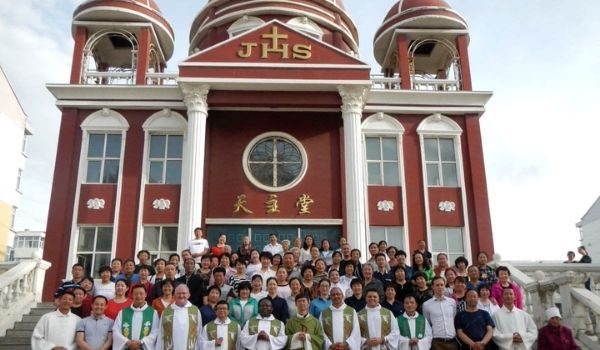
In a land area of approximately 55,000 square kilometers, the diocesan territory covers the prefecture-level city of Ulanqab in south-central Inner Mongolia Autonomous Region, following an adjustment to ecclesiastical territories by the government-sanctioned "open" Church community in accordance with civil administrative boundaries.
There are 3.17 million people, among which 84,300 are Mongols and 26,800 belong to other minor ethnicities.
Mandarin-, Chinese and Mongol dialect are in use.
The Vicariate Apostolic of Tsining (Jining) was erected in 1929 and elevated to a diocese in 1946. The diocese was entrusted to the Congregation of the Immaculate Heart of Mary (popularly called Scheut Fathers), who had come as missioners to Mongolia in the 19th century.
According to the Pontifical Yearbook, there were 36.240 Catholics among 800,000 people in 32 parishes in the diocese, served by 64 priests and 98 religious women.
After the Communists took rule of mainland China, the Scheut Fathers were expelled and the diocesan name was changed from Jining to Wumeng (Ulanqab League) in the 1950s to cope with the government's revision of the administrative division. The diocese's boundaries were pushed further out after several parishes from neighboring dioceses were incorporated into it.
The Meiguiying Cathedral was reopened in 1980 upon religious activities gradually revived after the Cultural Revolution (1966-76). As the country's religious policies become opener, more churches have been opened in late 1980s.
Father Ai Shijun led the diocese and made great efforts to the Church development. The state of vacant see ended when Bishop John Liu Shigong was ordained the first native bishop of Jining (Wumeng) in 1995. Today, there are about 100,000 Catholics served by Bishop Liu, 28 priests and 15 nuns.
A new cathedral, named Our Lady of the Rosary, was built in Jining in 2007. Much of the building, which has red walls, and white pillars and window frames, was done in Roman style. However, the domed roofs of the cupola and two bell towers were designed to resemble ger (yurt), the traditional round tents of nomadic Mongols, which can be seen in rural areas in Inner Mongolia.
Ulanqab's transportation network is well-developed, connected by several railways and highways. Some of the railways passing through the prefecture are the Beijing-Baotou, Jining-Erlianhot, and the Jining-Tongliao Railways. Major inter-provincial roads include the Beijing-Hohhot Expressway, China National Highway 110 (Beijing to Yinchuan) and 208 (Erlianhot to Changzhi).
Ulanqab features a cold semi-arid climate, marked by long, cold and very dry winters, warm, somewhat humid summers, and strong winds, especially in spring. More than half of the annual precipitation of around 360 mm falls in July and August alone.
Ulanqab is rich in mineral resources with 69 species have been found, including iron, manganese, chromium, platinum elements, aluminum, copper, gold, silver and nickel. There is also rich in a variety of non-metallic minerals.
Jining District is Ulanqab's administrative centre, which was formerly a county-level city. In December 2003, the former Ulanqab League was established as a prefecture-level city with an area of 54,491 square kilometers. Besides Jining district, Ulanqab includes one county-level city, five counties and four banners (tribal units). It borders Hohhot to the west, Mongolia to the north, Xilin Gol League to the northeast, Hebei to the east and Shanxi to the south.
In ancient China, Ulanqab and the rest of Inner Mongolia was a territory of Xiongnu, a conferderation of nomadic-based people north to the agriculture-based empire of the Han Dynasty (206 BC-220 AD). The name of Ulanqab League appeared in early Qing Dynasty (17th century), when six banners (tribal units) of Manchu formed a league.
Since the ancient times, Ulanqab is full of beautiful mountains, rivers and lush vegetation. The place contains various types of natural landscape, strong feature of nationalities, long history and rich culture such as grasslands, forests, mountains and rivers, lakes, ice and snow, volcanic groups, cultural relics, historic sites, temples, space base and other kinds of landscape, especially ecological grassland tourism with the combination of Mongolian culture is much unique.